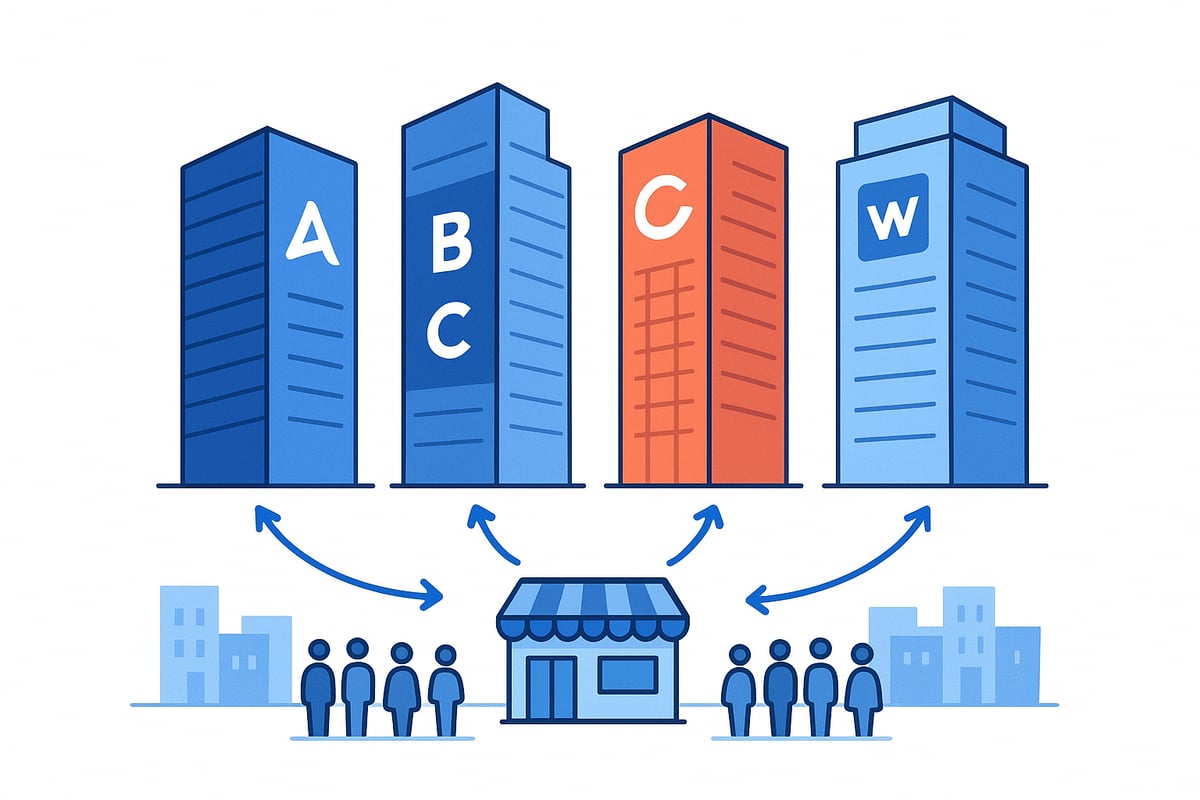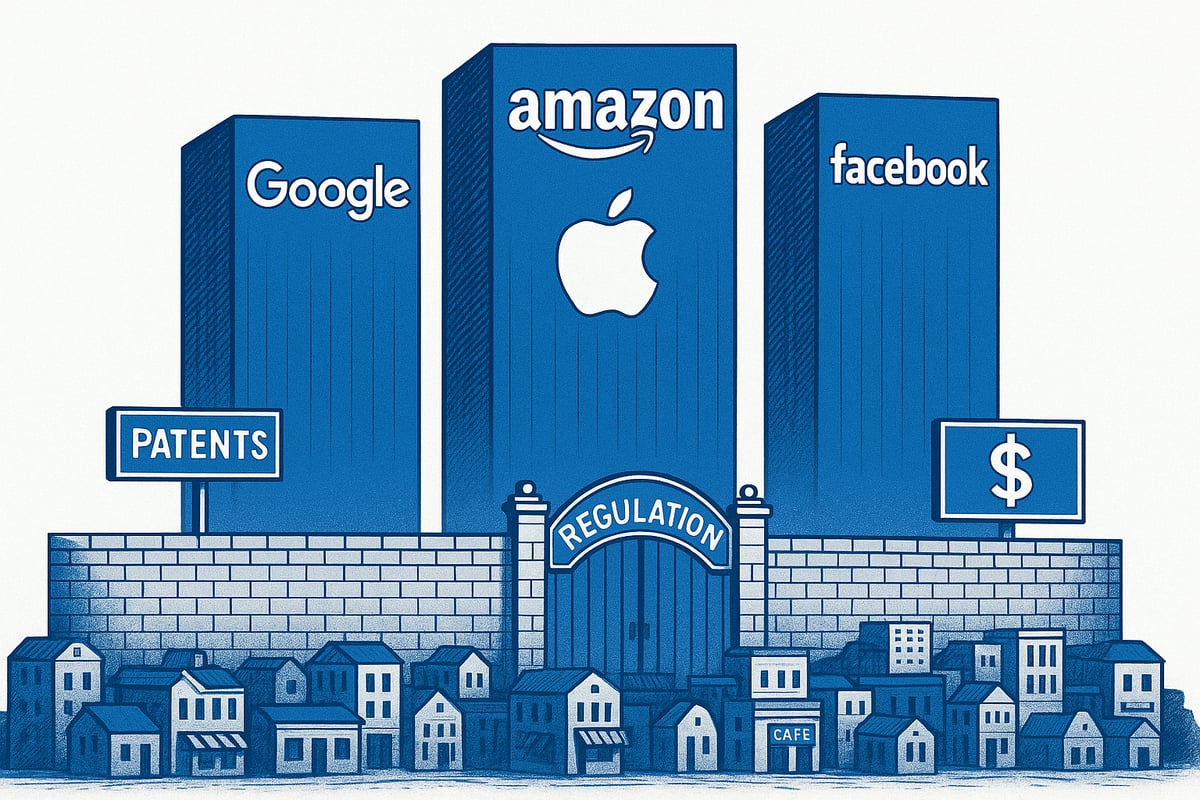Oligopoly Guide: Understanding Market Power in 2025
Imagine a marketplace where just a few companies decide what products you can buy, how much you pay, and even how quickly new ideas reach you. This scenario is not science fiction—it is the reality of oligopoly in 2025.
In this guide, we will break down the concept of oligopoly, helping you understand how a handful of powerful firms shape entire industries. You will see how these companies set prices, influence your choices, and impact innovation across the global economy.
Whether you are a business leader, consumer, or policymaker, gaining insight into oligopoly is essential. We will explore the defining features of this market structure, explain why oligopolies form, discuss how firms compete or cooperate, and analyze real-world examples. You will also discover what the future may hold for market power and competition.
Get ready to uncover the hidden forces shaping today’s economy and learn what oligopoly means for everyone involved.
What Is an Oligopoly? Defining the Market Structure
Understanding the oligopoly market structure is essential for grasping how a few powerful firms can shape entire industries. In an oligopoly, the actions of one company can ripple across the market, influencing prices, innovation, and consumer choices. Let’s break down what makes this structure unique and why it matters in today’s economy.

Key Characteristics of Oligopoly
An oligopoly exists when a handful of dominant firms control the majority of the market. Typically, three to five companies hold over 60 percent of the market share. This setup creates high barriers to entry, such as expensive equipment, strict regulations, or exclusive patents.
Products in an oligopoly can be identical, like crude oil, or differentiated, like branded soft drinks. The firms are interdependent, meaning each one’s pricing and output decisions affect the others. Consumers often have limited substitutes, which gives these firms the power to set prices above competitive levels.
For a deeper dive into these features and more examples, see the Oligopoly Definition and Characteristics resource.
Oligopoly vs. Other Market Structures
To truly understand oligopoly, it helps to compare it with other market structures. In a monopoly, a single supplier dominates, offering no substitutes. Perfect competition, on the other hand, features countless small firms selling identical products, making it impossible for any one to influence prices. Monopolistic competition sits in the middle, with many firms offering slightly differentiated products and low entry barriers.
Here’s a quick comparison:
| Structure | Firms | Product Type | Barriers to Entry | Price Power |
|---|---|---|---|---|
| Perfect Competition | Many | Homogeneous | Low | None |
| Monopolistic Competition | Many | Differentiated | Low | Limited |
| Oligopoly | Few | Homo/Differentiated | High | Significant |
| Monopoly | One | Unique | Very High | Complete |
Oligopoly’s unique blend of high concentration and significant power often results in higher prices and supply vulnerabilities for consumers.
Types of Oligopoly: Collusive vs. Competitive
There are two main types of oligopoly: collusive and competitive. In a collusive oligopoly, firms cooperate—either formally or informally—to set prices or output. This can lead to price stability, but it often comes at the expense of consumers. Famous examples include historical cartels like OPEC and the Lysine cartel.
Competitive oligopoly, by contrast, involves firms fiercely competing, sometimes triggering price wars that drive prices down. While explicit collusion is illegal in many countries due to antitrust laws, tacit agreements can still happen. The outcome for consumers hinges on whether firms choose stability or rivalry.
Measuring Oligopoly: Concentration Ratios and the HHI
Economists measure oligopoly using concentration ratios and the Herfindahl-Hirschman Index (HHI). The most common benchmarks are the four-firm, five-firm, and eight-firm concentration ratios. If the top five firms control more than 60 percent of sales, the market is considered an oligopoly.
The HHI provides a more detailed look by squaring the market shares of each leading firm and summing them. Regulators use these tools to analyze competition and assess the potential for market abuse. Real-world examples include the U.S. baby formula and airline industries, where a few firms dominate, raising concerns about pricing and supply stability.
Why Do Oligopolies Exist? Barriers to Entry and Market Evolution
Understanding why an oligopoly emerges requires a closer look at what prevents new firms from entering the market and why just a few companies come to dominate. Several core factors work together to create and sustain this unique market structure.

Barriers to Entry in Oligopolistic Markets
Barriers to entry are the primary reason an oligopoly can form and persist. These barriers make it difficult for new competitors to enter the market, allowing a handful of firms to maintain control. Typical barriers include:
- High capital requirements for equipment, technology, or infrastructure
- Strict regulatory standards and licensing, such as those enforced by the FDA
- Patents and proprietary technology that block newcomers
- Control over essential resources or distribution channels
- Economies of scale that favor established firms
For example, the broadcast television industry is limited by spectrum allocation, making it nearly impossible for new players to compete. To explore the structural features and real-world examples of oligopoly, see Oligopoly Market Structure Explained.
Market Demand and Economies of Scale
Another key driver of oligopoly is market demand combined with economies of scale. In many industries, only a few firms can efficiently meet consumer needs because the minimum efficient scale is so large. This discourages smaller companies from entering, as they cannot match the cost advantages of industry leaders.
Consider the soda industry: massive marketing budgets and widespread brand recognition mean only a handful of companies can operate profitably. When demand supports only a few large firms, the market naturally evolves into an oligopoly. Mergers and acquisitions further increase this concentration, making the structure even more entrenched.
Product Differentiation and Branding
Product differentiation and branding also help sustain an oligopoly. Through powerful advertising and the cultivation of brand loyalty, dominant firms make it tough for new entrants to win over customers. Established brands in global markets, such as leading soft drink or tech companies, benefit from consumer familiarity and high switching costs.
This differentiation acts as a barrier, giving incumbents pricing flexibility. Consumers often perceive few genuine alternatives, which keeps the market stable and reinforces the strength of the oligopoly.
Government Policy and Legal Barriers
Government policies shape oligopoly by granting patents, licenses, or other exclusive rights that limit competition. Regulatory requirements can be so strict that only a few firms can comply. For example, the U.S. baby formula industry faces both FDA regulations and import tariffs, restricting the number of suppliers.
Antitrust laws aim to prevent anti-competitive behavior but can be challenging to enforce, especially with tacit collusion. Internationally, regulatory environments differ, affecting how easily oligopoly can form. Policy decisions, especially during crises, can either reinforce or disrupt market concentration.
How Do Oligopolists Compete? Collusion, Competition, and Game Theory
In an oligopoly, the way firms interact shapes everything from prices to product choices. Unlike other markets, firms in an oligopoly constantly watch each other and respond to every move. Let us explore the key ways these companies compete and cooperate.

Collusion: Cartels and Tacit Agreements
Collusion is when firms in an oligopoly coordinate their actions to control prices or output. This can be explicit, like in cartels, or tacit, where companies simply follow each other's signals without direct communication.
- Formal cartels: OPEC for oil, the Lysine cartel in the 1990s.
- Tacit agreements: Firms adjust prices after one leader makes a move.
- Incentives: Higher profits, reduced uncertainty, and price stability.
However, explicit collusion is illegal in many countries and can result in heavy fines or criminal charges. Despite this, tacit collusion remains common since it is harder to detect and prosecute.
Competition: Price Wars and Strategic Rivalry
While collusion is tempting, firms in an oligopoly often end up competing aggressively. Price wars are a classic example, where one company cuts prices and others follow to avoid losing customers. This can erode profits for all players.
- Kinked demand curve: Firms match price cuts but not hikes.
- Mutual interdependence means every action gets a reaction.
- Airline fare wars show how quickly competition can escalate.
Understanding concepts like marginal cost in market structures helps explain why firms hesitate to lower prices below profitable levels. For consumers, competition can sometimes mean lower prices, but it also brings instability.
The Prisoner’s Dilemma in Oligopoly
The classic prisoner’s dilemma illustrates why cooperation in an oligopoly is hard to sustain. Each firm faces the temptation to cheat on agreements, hoping to gain more while others stick to the deal.
Below is a simple table showing possible outcomes for two firms:
| Both Cooperate | Both Compete | One Cheats, One Cooperates |
|---|---|---|
| High profits | Lower profits | Cheater wins, cooperator loses |
The dominant strategy is often to compete, even if both firms would be better off cooperating. This tension lies at the heart of many oligopoly markets.
Game Theory and Strategic Decision-Making
Game theory provides tools to analyze the strategic moves in oligopoly markets. Firms build payoff matrices to predict outcomes and decide whether to compete, cooperate, or threaten retaliation.
- Repeated games: Ongoing interactions encourage cooperation.
- Punishments: Threats of price wars can keep firms in line.
- Real-world examples: Intense advertising battles and innovation races.
By thinking several moves ahead, companies in an oligopoly try to anticipate rivals and maintain their competitive edge.
Enforcement and Breakdown of Cooperation
Maintaining cooperation is a challenge. Firms in an oligopoly may agree to quotas or set a price leader, but the temptation to defect for short-term gain is always present.
- Monitoring: Tracking output or price changes.
- Sanctions: Retaliatory price cuts or public denouncement.
- International cartels like OPEC struggle with member compliance.
When cooperation breaks down, markets can become volatile, with prices and supply swinging unpredictably.
Regulatory Oversight and Antitrust Actions
Governments play a crucial role in monitoring oligopoly behavior. Agencies like the DOJ and FTC in the U.S. investigate suspicious pricing or output agreements.
- Antitrust actions: Fines and criminal sentences for illegal collusion.
- International cooperation: Cross-border enforcement for global cartels.
- Ongoing challenge: Tacit collusion is hard to prove and regulate.
As oligopoly markets evolve, regulators must adapt their strategies to protect consumers and maintain fair competition.
Real-World Examples of Oligopoly in 2025
Understanding how oligopoly shapes markets requires looking at today’s most influential industries. These real-world examples reveal how a handful of firms wield significant market power, impacting prices, choices, and even supply stability across the globe.

Major Oligopolistic Industries Today
Many of the world’s most critical sectors are structured as oligopoly markets. In the U.S., four large airlines control over 80 percent of the domestic market. The global insulin market is another classic example, with just three firms holding more than 90 percent of supply. Technology, energy, and telecommunications also feature a few powerful players dominating their fields. For a deeper dive into the characteristics and additional types and examples of oligopoly, industry resources are invaluable.
- Airlines: Four firms, 80 percent+ U.S. market share
- Insulin: Three firms, 90 percent+ global share
- Energy: OPEC nations set oil prices
- Telecom: Few providers in most regions
These concentrated markets shape choices and competition for millions of consumers.
Case Study: U.S. Baby Formula Market
The U.S. baby formula market demonstrates how oligopoly can magnify vulnerabilities. In 2022, a supply crisis emerged after a major producer halted operations due to safety concerns. Strict FDA regulations, high entry costs, and import tariffs made it difficult for new suppliers to enter. As a result, just a few firms supplied nearly all U.S. formula, intensifying the shortage.
When the government temporarily relaxed import rules, the market adjusted, but the incident exposed the risks of relying on a tightly held oligopoly. This case underscores the importance of resilience and regulatory oversight in concentrated industries.
Case Study: Airline Industry Mergers
From 2005 to 2015, the U.S. airline industry underwent a wave of mergers. Four major carriers now dominate, exceeding an 80 percent concentration ratio. This transformation shifted the oligopoly landscape, reducing competition and giving airlines more control over fares and routes.
The impact on consumers has been mixed. While some benefit from extensive networks, others face higher prices and fewer choices, particularly in smaller markets. Regulatory authorities closely monitor such mergers to prevent excessive market power and protect consumer interests.
Technology and Digital Oligopolies
Digital markets illustrate oligopoly dynamics in action. Search engines are dominated by Google, with few viable competitors. Social media is largely controlled by Meta, Twitter, and TikTok. App distribution is a duopoly, with Apple and Google overseeing most downloads.
Network effects reinforce the dominance of these firms, making it hard for new entrants to gain traction. Antitrust investigations have increased, reflecting concerns about the growing influence of digital oligopoly players. The tech sector’s rapid evolution keeps regulators and consumers alert to shifts in power.
Global Perspectives: Oligopoly Beyond the U.S.
Oligopoly is not just a U.S. phenomenon. In Europe, telecom and energy industries are highly concentrated. Asian markets feature automotive and electronics oligopolies, where a few brands control significant market shares. International cartels, such as OPEC, set global oil prices, impacting economies worldwide.
Regulatory approaches differ by region, but the effects of oligopoly are similar: limited choices, price influence, and heightened risk of supply disruptions. Understanding these global patterns is key for businesses and policymakers navigating interconnected markets.
The Impact of Oligopoly on Consumers, Innovation, and Society
Understanding the impact of oligopoly is crucial for anyone interested in how modern markets function. In 2025, the influence of oligopoly reaches far beyond simple price tags, touching on innovation, market stability, and even the ethical fabric of society.
Price Setting and Consumer Welfare
Oligopoly markets wield significant power to set prices above competitive levels. With only a few firms dictating terms, consumers often face higher prices and fewer alternatives. Unlike perfect competition, where many sellers drive prices down, oligopoly participants can maintain price rigidity for extended periods.
Occasionally, price wars erupt, temporarily benefiting consumers. Still, these periods are rare and typically short-lived. The result is a persistent reduction in consumer surplus. Regulatory interventions, such as price ceiling and regulation, can help protect buyers, but enforcement remains a challenge in concentrated markets.
Product Quality, Innovation, and Choice
Innovation in oligopoly markets is a double-edged sword. On one hand, competition among a few giants can drive significant technological leaps as firms strive to differentiate products. On the other hand, reduced rivalry may lead to complacency, stifling innovation and limiting consumer choice.
Brand loyalty, fueled by heavy advertising, further entrenches oligopoly power. Consumers may struggle to find meaningful alternatives, as switching costs and marketing influence choices. The balance between innovation and stagnation depends heavily on how aggressively firms compete versus how much they rely on their established market positions.
Supply Chain Vulnerabilities and Market Stability
Supply chain resilience is a critical concern in oligopoly settings. When only a handful of firms control production or distribution, disruptions can ripple quickly through the market. The 2022 baby formula shortage demonstrated how concentrated supply can magnify vulnerabilities, leaving consumers exposed to shortages and price spikes.
Efforts to optimize efficiency often come at the expense of robustness. In oligopoly markets, a single point of failure can impact millions, highlighting the need for diversified supply chains and contingency planning. Policymakers and businesses must weigh efficiency against the risks of over-concentration.
Regulatory Challenges and Policy Responses
Regulating oligopoly requires vigilance and adaptability. Detecting tacit collusion is notoriously difficult, as firms may signal intentions through pricing or output rather than explicit agreements. Antitrust enforcement agencies work to identify and break up anti-competitive practices, but legal thresholds are high.
During crises, governments may intervene directly, waiving regulations or imposing temporary controls. Calls for liberalization and increased competition are common, yet achieving a balance between efficiency and consumer protection is complex. Regulatory frameworks must evolve to address the unique challenges posed by oligopoly power.
Societal and Ethical Considerations
Oligopoly structures raise important ethical questions about equity and access. When essential goods and services are controlled by a few, disparities in availability and affordability can widen. Large firms in oligopoly markets often wield substantial influence over public policy and regulation.
Ethical dilemmas arise as companies prioritize profit over social responsibility. Public perception of corporate power can shift, especially when market concentration leads to negative outcomes. Long-term, the societal impact of oligopoly extends to trust in institutions and the overall health of the economy.
The Future of Oligopoly and Market Power in 2025
Looking ahead, the future of oligopoly will be shaped by technological advancements, globalization, and regulatory shifts. Digitalization and AI may reinforce existing market power or enable new entrants to disrupt established players. The regulatory landscape is also evolving, with proactive policies aiming to ensure fair competition and protect consumer interests.
As market dynamics shift, the role of oligopoly in shaping prices, innovation, and societal outcomes will remain a central issue. Staying informed about these trends is essential for businesses, policymakers, and consumers navigating the complexities of oligopoly markets.
As we’ve explored, understanding how a few powerful firms can shape entire industries is essential in today’s market—especially as we look ahead to 2025. If you’re eager to dive deeper into the forces driving market power, or want to see the bigger picture behind the headlines, we invite you to join our community. With interactive tools, AI-powered insights, and a historical lens on finance, you’ll be empowered to spot patterns and make smarter decisions. Ready to help shape the future of financial understanding? Join our beta and help us bring history to life.
